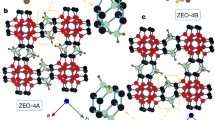Abstract
MOST metals other than those having a face-centred cubic structure show a more or less rapid transition from ductile to brittle behaviour as the temperature is lowered. Well above the transition temperature the fracture surfaces are mainly fibrous with only a few cleavage facets, but at intermediate temperatures fracture occurs by cleavage after a strain of a few per cent. So far little attention has been paid to the mechanism of this ductile cleavage fracture. Recently, we have examined cleavage facets and longitudinal sections of a number of fractured specimens in which cleavage occurred after straining about 10 per cent at room temperature at a rate of strain of 0.88 × 10−4 sec.−1. The tensile specimens, which had grain diameters of about 2 mm., were prepared from arc-cast deoxidized molybdenum and were 0.1 in. in diameter1. The results throw some light on the mechanism of fracture.
This is a preview of subscription content, access via your institution
Access options
Subscribe to this journal
Receive 51 print issues and online access
$199.00 per year
only $3.90 per issue
Buy this article
- Purchase on Springer Link
- Instant access to full article PDF
Prices may be subject to local taxes which are calculated during checkout
Similar content being viewed by others
References
Johnson, A. A., Phil. Mag., 4, 194 (1959).
Low, J. R., Madrid Colloquium on Deformation and Flow of Solids (Springer-Verlag, 1956).
Author information
Authors and Affiliations
Rights and permissions
About this article
Cite this article
JOHNSON, A., SHAW, B. Ductile Cleavage Fracture of Molybdenum. Nature 183, 1542–1543 (1959). https://doi.org/10.1038/1831542b0
Issue Date:
DOI: https://doi.org/10.1038/1831542b0
This article is cited by
-
The effect of grain size on the deformation resistance of nickel
Soviet Physics Journal (1968)
Comments
By submitting a comment you agree to abide by our Terms and Community Guidelines. If you find something abusive or that does not comply with our terms or guidelines please flag it as inappropriate.



